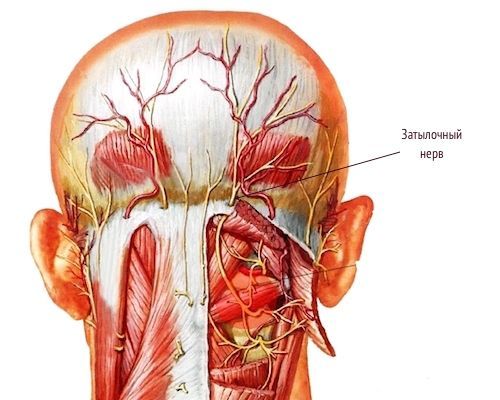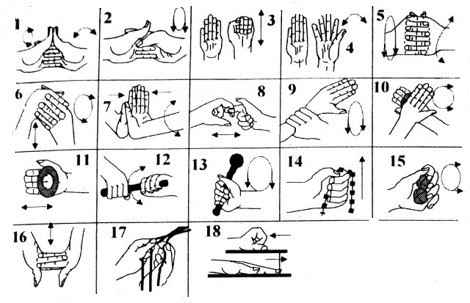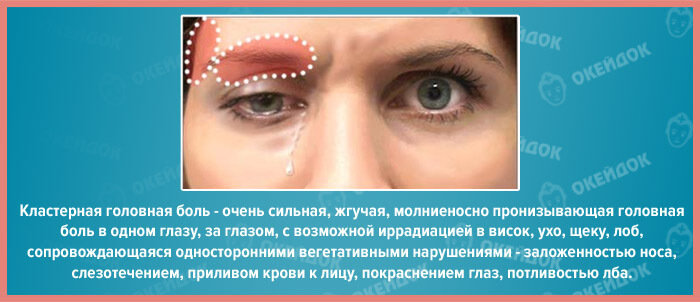Occipital neuralgia: symptoms and treatment
The occipital nerve endings are branches from the nerve peripheral innervation, their the main function is the initial transmission of a nerve impulse from the brain to peripheral tissues.
The occipital nerve is divided into two roots large and small, which are located in the region of the foramen magnum. When the roots are squeezed, irritation develops, and in the future, inflammation of the occipital nerve.
Occipital neuralgia is characterized by intense throbbing headaches and other pathological symptoms.
Content
- Features of the symptomatic manifestation of pathology
- Etiological factors in the development of the disease
- Diagnostic measures
- Therapeutic measures for neurological pathology
- Surgical intervention for neuralgia
- Possible complications of the disease
- Treatment of occipital neuralgia with medicinal plants
- Prevention of the development of the disease
- Patient recovery prognosis
- Related Videos
Features of the symptomatic manifestation of pathology

In cases where inflammation of the occipital nerve develops, the main manifestation of the disease will be pronounced soreness. As a rule, pain is localized in the back of the head, and it has its own special characteristics:
The main symptom that manifests itself with neuralgia of the occipital nerve is excruciating pain in this area. Its belonging to the disease can be determined by the following symptoms:
- pain is characterized by a burning sensation, manifested by periodic impulses;
- it is mainly characterized by an arrangement, preferably on the one hand, very rarely the soreness has a diffuse character;
- irradiation of pain to the back of the neck, the angle of the lower jaw from the affected side;
- pain attacks recur a huge number of times throughout the day;
- provoke the development of symptoms, a sharp change in body position, bright light, intense sound stimulus, even minimal sound stimuli can contribute to the development of the disease.
With neuralgia of the occipital nerve, the sensitivity of the skin in the affected area can change, and sometimes the complete absence. In this case, the patient feels a feeling of numbness.
If inflammation of the occipital nerve progresses, symptoms of dyspeptic disorder and focal neurological symptoms begin to appear.
A distinguishing feature from diseases such as arterial hypertension and migraine headaches is a long period of pain, while neuralgia of the occipital nerve manifests itself in short-term attacks.
Etiological factors in the development of the disease
The main etiological factors in the development of neuralgia:
- Osteochondrosis of the cervical spine symptomatically manifests itself as an acute and chronic course of the disease. In this disease, degeneratively altered vertebral bodies squeeze the nerve roots of the occipital nerve passing through the occipital foramen. As a result of such pathological processes, characteristic symptoms develop.
- Traumatic injuries of the spine in the cervical spine, while the nerve is compressed by bone fragments.
- Oncological formations in the spinal canal.
- Congenital or acquired changes in a person's posture.
- Long-term and intense physical overvoltage is associated with harmful working conditions.
- Prolonged depression.
- General hypothermia of the body.
- Rheumatic lesions of the connective tissue of the body.
- Infectious bacterial or viral diseases of the body.
- Disruption of the functioning of the human immune system in response to the ingress of foreign agents into the body.
- Acute or chronic poisoning of the body with alcohol surrogates and medicinal substances.
Read also:Spinal osteochondrosis: symptoms and treatment
Correct identification of the etiological factor of the disease determines the symptoms and treatment of the disease. The effect of the neuralgia treatment the occipital nerve will completely depend on what is the etiology of the development of the disease, since before starting symptomatic treatment, the action of the etiological factor is eliminated.
Diagnostic measures
At the heart of the diagnosis, the patient is supposed to conduct a general survey and examination. A laboratory blood test is carried out to determine the presence of an inflammatory process in the body or to exclude it.
As instrumental diagnostics, the following is carried out:
- X-ray of the neck area to detect cervical osteochondrosis or assess the nature of traumatic injury;
- magnetic resonance and computed tomography is performed if there is a suspicion of oncological pathology.
Therapeutic measures for neurological pathology
Final recovery from neurological symptoms is most likely if the patient has sought help in the early stages of the disease and depending on how effectively the etiotropic treatment was carried out diseases. Correct conservative therapy will prevent the need for surgery.
For conservative therapy, the following medications are used:
- Non-steroidal anti-inflammatory drugs are prescribed to relieve painful sensations and to prevent the spread of the inflammatory process.
- Myo relaxants are used to relax muscle fibers.
- Anticonvulsants stop the convulsive contraction of muscle fibers.
- Steroid medicines are used when conventional pain relievers do not have a beneficial effect.
- Sedatives with B vitamins are used to improve cerebral blood flow and thereby improve nutrient intake.
The above groups of drugs are used only as symptomatic treatment, but long-term use of these drugs will not eliminate the pathology, but only copy the symptomatic manifestations.
Additionally, patients are prescribed physiotherapy procedures to alleviate the general condition of the patient. Non-drug additional treatment is carried out with the help of:
- massage of the back of the head and neck;
- electrophoresis, magnet, heat energy to the affected area;
- exposure to radiant and laser energy;
- specially selected physical exercises;
- traction of the spine using manual therapy.
Read also:Concussion
In the event that there has been a significant lesion of the roots of the occipital nerve, and medication correction does not show a positive result, patients are shown surgical interference.
Surgical intervention for neuralgia
Surgical intervention for occipital neuralgia can be performed using two methods:
- Microvascular decompression - this technique is carried out in order to eliminate the etiological factor that promotes compression of the nerve roots of the nerve, this will help restore the normal passage of the nerve impulse along the occipital nerve.
- Neurostimulation - this technique is performed for organic pathology of the occipital nerve, during surgery on nerve endings are installed with specialized microscopic sensors that will help the nerve to conduct nerve impulses.
Surgical techniques for restoring nerve impulses along the occipital nerve should be performed only under the supervision of a qualified specialist.
Possible complications of the disease
In cases of improperly selected etiotropic and symptomatic treatment of the inflammatory process along the fibers of the occipital nerve, it can spread to nearby structures. Against the background of the progression of the disease, the following complications may appear:
- Neuropathy is a specific complication characterized by structural changes in the membranes nerve fibers, this contributes to the development of excessive sensitivity of the nervous tissue to any kind irritants. Structural changes in muscle fibers contribute to the development of intense pain.
- Blindness, this complication develops if the inflammatory processes progress and spread to the nerve fibers of the optic nerve, provoking the development of its atrophy.
- In order to reduce the intensity of painful sensations, a sick person uses a certain comfortable posture for him. Over time, a person experiences deforming changes in the vertebrae of the cervical spine, thus torticollis is gradually formed.
- Changes in the mental state occur in cases of persistent pain syndrome.
Treatment of occipital neuralgia with medicinal plants
Medicinal plants can be used as an additional method of treatment, but it is not considered as the main method. The attending doctor must control the intake of traditional medicine.
For the treatment of folk remedies, you can use the following recipes:
- Baths from the collection of medicinal plants: Dried leaves of oregano, thyme, and mint are ground, mixed thoroughly and poured with a glass of warm water. The resulting solution is filtered into a shallow feed and added to the bath. It is recommended to take a medicated bath daily before bedtime.
Read also:Dyscirculatory encephalopathy of 1, 2 and 3 degrees, what is it, symptoms and methods of treatment

- Beetroot ear drops: Peel fresh beets, rub with a fine grater, then squeeze out the juice. The pure juice obtained should be instilled into the ears 2-3 drops 2-3 times a day.

- Healing tea from St. John's wort: Dried leaves of a medicinal plant in the amount of one tablespoon is necessary pour 250 ml of boiled water, let it brew for 10 minutes, after which the tea is ready for addicting. St. John's wort tea can be drunk three times a day without fear of overdose. During treatment with this plant, it is necessary to be under the open sun as little as possible, since prolonged exposure to ultraviolet radiation can adversely affect human skin, causing allergic reactions.

- Local mustard compress: A powder made from the mustard plant is steamed with boiling water until thick consistency, after the mustard has cooled, it is applied to a dry napkin and applied to the affected region. For a more pronounced warming effect, the painful area is additionally wrapped with a scarf or any other warm materials.
Prevention of the development of the disease
As a preventive measure, you should:
- avoid traumatic injuries to the back of the head and neck;
- engage in more bladeless sports;
- timely treatment of infectious diseases;
- get rid of the use of toxic alcohol surrogates;
- conduct periodic examinations for oncopathology.
Patient recovery prognosis
The prognosis for the complete recovery of a patient with occipital neuralgia depends on how timely it is asked for qualified medical help from what is the etiological factor in the development of this diseases. In cases of significant organic or traumatic damage to the structure of the roots of the occipital nerve, the prognosis for complete recovery is largely difficult.
In the initial stages, the disease is very successfully treated with the help of conservative methods.



